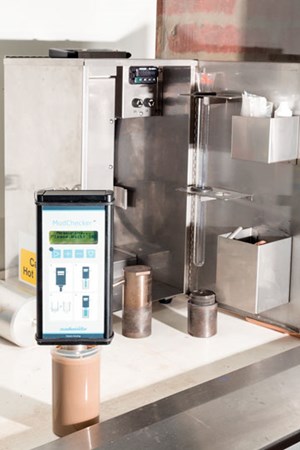Merit of hand-held drilling fluid sensor proved in field trials
British independent oil and gas E&P company, IGas Energy plc, develops onshore oil and gas fields. The firm produces more than 2,500 boed from more than 100 sites across the UK.

Accordingly, the company decided to enhance production at its Stockbridge oil field, and to drill three sidetracks from existing wells. This involved new reservoir development work, which saw the re-entry of existing wells to develop new areas in the field and boost production. The sidetracks were drilled directionally and entered the formations horizontally. Between 700 and 1,500 m of new hole were completed from the kick-off point in the original wellbores.
An important element of the drilling program covered the management and control of mud fluids, fulfil several critical functions, including pressure control, lubrication of the wellbore, cuttings removal and hole stability. The most fluid-sensitive rock formations at the Hampshire site, clays, were drilled using an oil-based drilling fluid (OBM) requiring measurement at regular intervals for oil, water, solids and chloride content. Regular analysis of fluid composition is a pivotal task during any exploration drilling work.
Field trial. To meet this need, IGas trialled the MudChecker drilling mud analyzer (Fig. 1) from Salunda, as a potentially beneficial alternative to the onerous, time-consuming retort and titration analysis method. This analyzer is the first electronic diagnostic device of its type for fast, accurate measurement of several critical parameters of oil-based drilling fluids.
The Stockbridge trial involved the evaluation of an early MudChecker prototype during several test sessions. This was an effective way to check the drilling fluids, assessing the hand-held analyzer’s capacity to provide rapid, consistent measurement of percentage oil, solid and water volumes, when compared to results gained through initial retort analysis.
The trial revealed that the analyzer, which is simple and easy to operate, could provide fluid analysis up to six times faster than traditional methods, producing consistently accurate measurement data.
According to IGas mud engineer Bob Sharp (who oversaw the project as an independent consultant), the trial confirmed the analyzer’s potential capability as a viable, reliable and cost-effective method, to effectively become a long-term test replacement to the retort method.
Results. “After some fine tuning, the MudChecker started to produce comparable results to that of the retort method, but far more quickly and consistently,” said Sharp. “Indeed, I would estimate that usable measurements were provided within 15 min., when compared to the 90 min. it took using retort analysis. Moreover, the analyzer is much simpler to use, which will be of benefit to mud engineers and operators. The trial revealed that it could significantly cut testing times and improve the efficiency of measuring fluid characteristics, both in the field and in mud plant activities.”
He noted that using data provided by the analyzer will improve fluids maintenance and checking during drilling, enabling changes in content to be made quickly and more accurately. “It will also enable companies to perform tests easier and more conveniently.
Features. Incorporating patented, sensitive radio-frequency technology, the analyzer features an integral sensor probe that is used to test a sample to provide an accurate, real-time in-field measurement of mud fluid content and temperature. Consistent and repeatable results are displayed quickly on an integral LCD screen to indicate percentage oil, solid and water volumes. It also records the oil/water ratio (OWR), oil/brine ratio (OBR) and water-phase salinity. Control of these parameters can be critical for mud stability, as well as avoiding wellbore collapse, that might otherwise result in equipment loss or damage, and non-productive time.
The captured data can be up loaded quickly via a USB interface, to a supporting software program, and can be exported for formal record-keeping and reporting. Salunda has propriety software available to log, export and print out results. ![]()
- Applying ultra-deep LWD resistivity technology successfully in a SAGD operation (May 2019)
- Adoption of wireless intelligent completions advances (May 2019)
- Majors double down as takeaway crunch eases (April 2019)
- What’s new in well logging and formation evaluation (April 2019)
- Qualification of a 20,000-psi subsea BOP: A collaborative approach (February 2019)
- ConocoPhillips’ Greg Leveille sees rapid trajectory of technical advancement continuing (February 2019)


